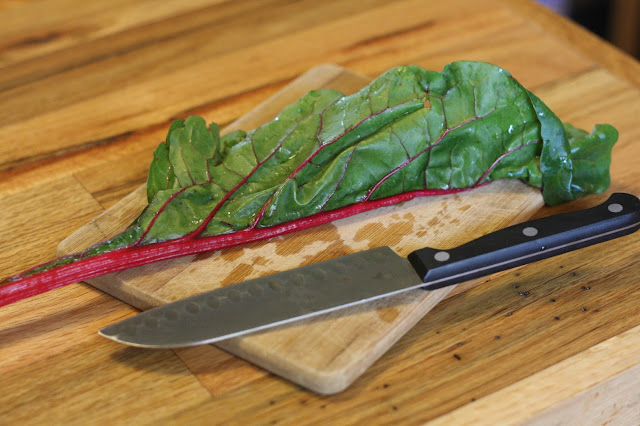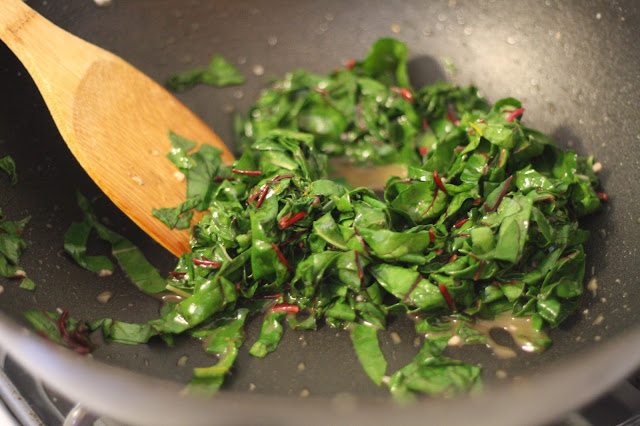Swiss Chard is very closely related to beets. Their leaves are almost indistinguishable from each other, so Swiss Chard can be substituted for any recipe that calls for beet greens. Unlike beets, Swiss Chard does not grow an edible root. It is simply grown for it's green leaves. The baby Swiss Chard leaves can be harvested as a colorful addition to fresh salads, but most Chard is used when mature in cooked dishes. Chard is an accomodating plant - it's not fussy, can be planted just about anywhere and it's quite cold hardly. Here in Michigan, I've been able to harvest Swiss Chard in the middle on January. The leaves can be harvested individually or you can cut off the whole plant 1 inch from the base - and then a new plant will grow in it's place!
I tried cooking the Swiss Chard and serving it as a side dish, but we found the flavor to be lacking and we decided we just were not fans of cooked greens. Then I found ways to sneak it into meals - it seemed to disappear into stir fry dishes and it was lovely in omelets or baked egg frittatas. I liked the fresh leaves on a breakfast egg sandwich. But I still wasn't using enough of the Chard. It still stood out there in the garden, looking beautiful and dejected.
And then a friend introduced me to this recipe. Jackpot!!! I couldn't get enough it. The recipe calls for 6-12 leaves, which makes a serious dent in the Chard supply in the garden. I used about 8 leaves the first time I tried it (which is giant pile of leaves!), thinking it would make a large side dish for dinner. Wrong. Those leaves cook down to almost nothing and I was left with one tiny little (delicious!) bowl of cooked greens. I gobbled it up by myself and wished I had more.
This is a recipe that can be tweaked and played with. The amounts are rough estimates, since I'm not a big fan of measuring things. Just try it and change it until it suits your tastes.
- 1 Bunch of mature Swiss Chard (6-12 leaves)
- 1 Clove of Garlic, finely chopped or crushed
- Butter (about a tablespoon?)
- Red Wine Vinegar (a splash)
- Kosher Salt (a pinch)
- Egg (this is an optional addition that transforms it from side dish into a meal -great for breakfast or lunch!)
1. Wash the Swiss Chard and dry it with a clean towel.
2. Fold a leaf in half.
3. Cut off the stalk/rib. I usually discard it, but some people enjoy eating it. If you decide to chop it up and use it, make sure you cook the stalk about 3-4 minutes before you add the leaves, because the stalk takes longer to cook.
4. Roll up the leaf.
5. Slices the rolled up leaf into ribbons. Repeat this process with all the remaining leaves.
6. Melt butter in a large non-stick pan (you can use a cast iron pan or a wok). If you are including an egg in the recipe, now is the time to cook your fried egg. Set it aside on a plate once it is done. Then add the minced/crushed garlic to the pan and sauté for about 1 minute, until fragrant. If you are not cooking an egg, then simply sauté the garlic in the butter.
7. Add all the Swiss Chard to the pan at once. Sprinkle with a pinch of sea salt and add a splash of red wine vinegar.
8. Keep moving the Swiss Chard around in the pan. It will cook very quickly, in about 3 minutes. Stir constantly and cook until Chard is wilted and still green, but not "dead", soggy and brown.
9. Serve immediately. If you made an egg to go with it, then slide the Chard over top the egg and enjoy! If you have a piece of crusty bread to sop up the butter and vinegar that will be left on your plate, even better. Yum!
There you go - a super quick and easy side dish or meal that will do justice to the lovely Swiss Chard in your garden! What is your favorite way to eat Swiss Chard? Do YOU have a recipe to share?!?
Disclaimer: I ADORE this recipe. My husband thinks it's "meh". He will eat some, but just because he loves me and makes me want to feel appreciated. My kids won't touch it, despite my attempts to have them try it. One time, I got my 4 year old daughter to take a bite because I called it "Pretty Ribbons". She spit it out. Just being real, folks - I don't want you to think that my family willingly eats all the food I make!










The book, Greens, Glorious Greens is stuffed full of great Chard recipes. A recipe book no kitchen should be without!!!
ReplyDeleteThanks for the tip! I have another book I really like too, that I plan on sharing next week. It's called "Serving Up the Harvest".
ReplyDelete